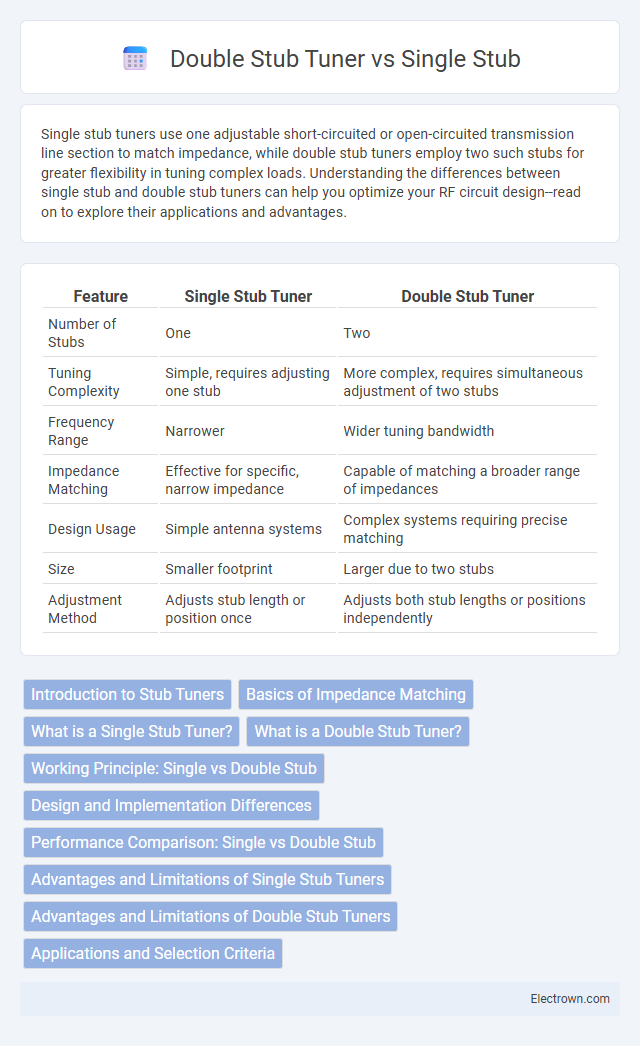Single stub tuners use one adjustable short-circuited or open-circuited transmission line section to match impedance, while double stub tuners employ two such stubs for greater flexibility in tuning complex loads. Understanding the differences between single stub and double stub tuners can help you optimize your RF circuit design--read on to explore their applications and advantages.
Table of Comparison
| Feature | Single Stub Tuner | Double Stub Tuner |
|---|---|---|
| Number of Stubs | One | Two |
| Tuning Complexity | Simple, requires adjusting one stub | More complex, requires simultaneous adjustment of two stubs |
| Frequency Range | Narrower | Wider tuning bandwidth |
| Impedance Matching | Effective for specific, narrow impedance | Capable of matching a broader range of impedances |
| Design Usage | Simple antenna systems | Complex systems requiring precise matching |
| Size | Smaller footprint | Larger due to two stubs |
| Adjustment Method | Adjusts stub length or position once | Adjusts both stub lengths or positions independently |
Introduction to Stub Tuners
Stub tuners are essential microwave components used to match impedances and minimize signal reflection in transmission lines. A single stub tuner consists of one adjustable short or open circuit stub placed at a precise distance from the load, whereas a double stub tuner employs two stubs for finer impedance matching over a broader frequency range. Your choice between single and double stub tuners depends on the complexity of the impedance mismatch and the required tuning flexibility.
Basics of Impedance Matching
Single stub and double stub tuners are essential tools for impedance matching in RF circuits, enabling the correction of mismatched loads to optimize power transfer and minimize signal reflection. A single stub tuner uses one adjustable stub connected at a specific distance from the load to cancel reactive components, while a double stub tuner employs two stubs for more flexible impedance correction across a wider frequency range. You can achieve precise matching with double stub tuners when complex impedance conditions exist, but single stub tuners offer simplicity and ease of use for straightforward matching tasks.
What is a Single Stub Tuner?
A Single Stub Tuner is a transmission line matching device used to eliminate signal reflections by adjusting the impedance in RF circuits. It consists of a single adjustable stub, either open or short-circuited, connected at a precise distance from the load to achieve impedance matching. This tuner simplifies design but may require careful positioning for effective impedance correction in microwave systems.
What is a Double Stub Tuner?
A Double Stub Tuner is a type of impedance matching device consisting of two adjustable short-circuited stubs separated by a certain length of transmission line. It allows precise tuning over a wider bandwidth compared to a Single Stub Tuner by independently adjusting the length of each stub to cancel out reactive components of the load impedance. This tuner is commonly used in RF and microwave systems to achieve optimal power transfer and minimize signal reflections.
Working Principle: Single vs Double Stub
A single stub tuner uses one adjustable reactive element, typically a shorted or open transmission line segment, placed at a specific distance from the load to cancel out the reactive component and achieve impedance matching. In contrast, a double stub tuner employs two adjustable stubs separated by a fixed transmission line section, allowing for more precise control over both reactive and resistive components without the need to vary the distance from the load. This dual-stub configuration offers greater flexibility and bandwidth for impedance matching in RF and microwave circuits compared to the single stub approach.
Design and Implementation Differences
Single stub tuners use one adjustable reactive element placed at a specific distance from the load to cancel out impedance mismatches, making their design simpler and more compact. Double stub tuners incorporate two adjustable stubs separated by a fixed transmission line section, offering greater flexibility in impedance matching and enabling tuning without changing the line length. The implementation complexity increases with double stub tuners due to precise spacing and independent tuning of each stub for optimal performance across a broader frequency range.
Performance Comparison: Single vs Double Stub
Single stub tuners offer simpler design and faster tuning but may provide limited impedance matching range compared to double stub tuners. Double stub tuners enable more precise impedance matching over a wider frequency band, enhancing overall system performance in complex RF environments. Your choice between single and double stub tuners should consider the trade-off between design complexity and desired matching accuracy.
Advantages and Limitations of Single Stub Tuners
Single stub tuners offer simple design and easy implementation, making them ideal for matching impedances in narrow bandwidth applications. Their compact size and minimal components reduce cost and complexity but limit effectiveness to specific frequencies, requiring precise positioning to achieve optimal tuning. You benefit from quick adjustments, though single stub tuners lack the flexibility and broader frequency range coverage found in double stub tuner configurations.
Advantages and Limitations of Double Stub Tuners
Double stub tuners offer the advantage of providing precise impedance matching over a wider range of frequencies compared to single stub tuners, making them highly effective in complex RF circuits. Their two adjustable stubs allow for greater flexibility in tuning and can compensate for larger reactance mismatches, enhancing overall transmission efficiency. However, double stub tuners require more space and involve a more complex design and calibration process, which can limit their practicality in compact or cost-sensitive applications.
Applications and Selection Criteria
Single stub tuners excel in applications requiring compact and simple impedance matching, such as in mobile communication devices and low-power RF circuits, due to their ease of implementation and minimal component count. Double stub tuners are preferred in high-power systems and broadband applications, like satellite transceivers and radar equipment, for their enhanced matching flexibility and improved bandwidth control. Selection criteria depend on factors including frequency range, power handling, available space, and required matching precision.
Single Stub vs Double Stub Tuner Infographic

 electrown.com
electrown.com